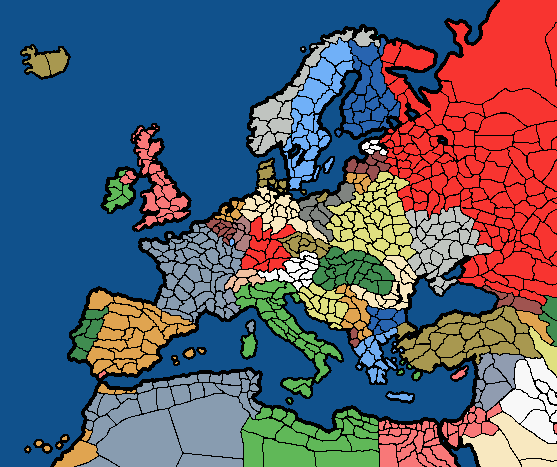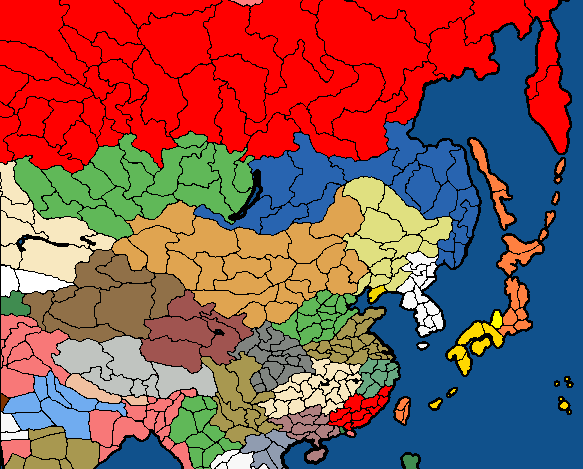FER and Siberia
The weakness of the Red Army, combined with the death of Grigory Seymonov on one of his raids on the Trans-Siberian Railway, insured that the White Movement got enough supplies to continue resisting the Soviet Union. However, the various socialists in the Russian Far East threatened this position, and only by the creation of the buffer state of the Far Eastern Republic could the White Movement continue. Kolchak proclaimed the Republic of Siberia, and began industrializing in hope to fight against the Bolsheviks once more. Meanwhile, Roman Ungern von Sternberg, who had seized power in Mongolia back in 1920, continued on with his pursuit of pan-monarchist goals.
Indochina Fractured
The success of the Indian rebel nations was the beginning of a small gulf of nationalism across East Asia. French Indochina rose up in revolt in 1930, as the success of the Yen Bai Mutiny spread across the Union. Vietnam gained independence while Siam regained their empire in Cambodia.
Trouble in Japan
Meanwhile in Japan, the Empire had not been able to overcome the hard times of the Great Depression. The assassination of Takahashi Korekiyo by a radical military officer for his fiscal policies involving reduction of military expenditures, prolonged the recovery of the economy. This resulted in a polarization of the ideologies in Japan, with a growth in the communist movement.
The Manchurian Incident seemed to be the end of the tunnel for Japan, as the Kwantung Army began their invasion of Manchuria. However, they miscalculated a factor that turned what could have been a clean conquest into a nightmare: the Korean Rebellion. The various guerilla forces in southeastern Manchuria knew that it was only a matter of time before the Japanese conquest of Manchuria will threaten their position, so they decided to do a daring invasion of their homeland. When the Chosen Army of Japan sent half of their forces into Manchuria to help the Kwantung Army, the Korean forces struck. They managed to take over Northeastern Korea, sparking a massive rebellion centering on Prince Imperial Ui.
The Ascending Phoenix: the Korean Empire
The Korean Rebellion was the turning point for the Japanese Empire on the Mainland. As Japan was forced to commit more troops into Korea and Manchuria to hold the line, more and more Japanese lost their faith in the government, leading to demonstrations and desertion. Internal disorder hit Japan as many of the poorer in society were increasingly left behind in Japan’s futile wars, and the disability to contain the revolutionary forces rising up lead to a communist revolution hitting parts of the army.
The attempted communist revolution brought Japan to the breaking point, and so Japan made a deal with the Koreans: The Korean Empire will be revived. Prince Imperial Ui accept the proposal, and so the Korean Empire was reborn.
The Korean Empire, enjoying its new freedom, moved to annex parts of Gando, where a Korean majority had been established due to Japanese rule. With the investments of the Japanese Zaibatsues, who did not want to risk their money on the rebellious Japanese workers, Korea continued on with its industrialization which started during the Japanese occupation. Although it is not the world power like Japan, it has certainly gained a place in the international community as a modern constitutional monarchy. It now works to "regain" territory that was disputed in 1712 with the former Qing Dynasty.
The Two Suns: Imperial and Communist Japan
Initially the earnest junior officers believed that the Emperor did not know what was going on and hoped to open his eyes. But the Imperial court was too conservative and the revolution quickly radicalized into a full-blown revolution. Although the peace with Korea helped the conservatives, the communists succeeded in taking over the government, when the Tokyo Fleet joined the revolution. This was the founding of the People’s Republic of Japan.
Meanwhile, the Emperor barely escaped, the Imperial Guard having sacrificed themselves to move him out of the city. The Loyalists, reinforced by the Kwantung Army from the mainland, kept a hold on western Japan and the Pacific Islands, and made their capital at Hiroshima. For the second time in their history, the Japanese were split into two countries.
Fractured China
In the 20's China was plunged into civil war, as various warlords (Kuomintang, Anhui, Yunnan, Guominjun and more) fought for control. Although the Kuomintang consolidated power with the Northern Expedition, the defeat in the Central Plains War both bankrupted the Kuomintang and ensured that the Warlords would continue to possess their power, with pro-monarchists managing to receive Japanese aid and set up Pu Yi as a figurehead of an Imperial China and the Soviet Republic of China obtaining a firm foothold in Southern China with help from PRJ.
Only one person had profit from the chaos in China. That person was no other than Roman Ungern von Sternberg. While China was thrown into civil war, he had seized the opportunity to absorb large portions of the territories owned by the warlords.






